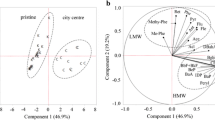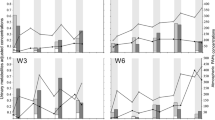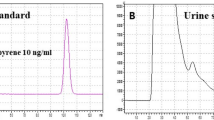Abstract
Concentrations of benzo[a]pyrene (B[a]P) in ambient air from different areas in Lanzhou city in northwest of China, and its metabolite 1-hydroxypyrene (1-OHP) in the urine of resident children and adults were determined by using gas chromatography/mass spectrometry and high performance liquid chromatography. Results showed that the atmospheric environmental concentration of B[a]P varied significantly from one part of the city to another with levels of 150 ng/m3 in the industrial area of Xigu and 73.8 ng/m3 in the agricultural area of Yuzhong. The geometric mean urinary 1-OHP concentration was 0.42 µmol/mol-creatinine, with a range of means between 0.067 and 2.05 for the various population sub-groups. The non-occupationally exposed populations’ age, gender and area of residence were the major factors that influenced urinary 1-OHP levels. The health risks of B[a]P for adults and children in Xigu and for children in Yuzhong exceeded the acceptable level (1 × 10−4) of the US Environmental Protection Agency.




Similar content being viewed by others
References
Bai ZP, Hu YD, Yu H et al (2009) Quantitative health risk assessment of inhalation exposure to polycyclic aromatic hydrocarbons on citizens in Tianjin, China. Bull Environ Contam Toxicol 83(2):151–154
Boogaard PJ, van Sittert NJ (1995) Urinary 1-hydropyrene as biomarker of exposure to polycyclic aromatic hydrocarbons in workers in petrochemical industries: baseline values and dermal uptake. Sci Total Environ 163:203–209
Chen B, Hu YP, Jin TY et al (2007) Higher urinary 1-hydroxypyrene concentration is associated with cooking practice in a Chinese population. Toxicol Lett 171:119–125
Chuang JC, Callahan PJ, Lyu CW et al (1999) Polycyclic aromatic hydrocarbon exposures of children in low-income families. J Expo Anal Environ Epidemiol 9:85–98
CN MEP, CN AQSIQ (2012) Ambient air quality standards (GB 3095–2012)
Freire C, Abril A, Fernández MF et al (2009) Urinary 1-hydroxypyrene and PAH exposure in 4-year-old Spanish children. Sci Total Environ 407:1562–1569
Guo H, Lee SC, Ho KF et al (2003) Particle-associated polycyclic aromatic hydrocarbons in urban air of Hong Kong. Atmos Environ 37:5307–5317
Guo Y, Senthilkumar K, Alomirah H et al (2013) Concentrations and profiles of urinary polycyclic aromatic hydrocarbon metabolites (OH-PAHs) in several Asian countries. Environ Sci Technol 47:2932–2938
Han Y, Xia Y, Zhu P et al (2010) Reproductive hormones in relation to polycyclic aromatic hydrocarbon (PAH) metabolites among non-occupational exposure of males. Sci Total Environ 408:768–773
Heudorf U, Angerer J (2001) Internal exposure to PAHs of children and adults living in homes with parquet flooring containing high levels of PAHs in the parquet glue. Int Arch Occup Environ Health 74:91–101
Hong HS, Yin HL, Wang XH et al (2007) Seasonal variation of PM10-bound PAHs in the atmosphere of Xiamen, China. Atmos Res 85(3–4):429–441
Huang WL, Grainger J, Donald G (2004) Comparison of 1-hydroxypyrene exposure in the US population with that in occupational exposure studies. Int Arch Occup Environ Health 77:491–498
Huang WL, Caudill SP, Grainger J et al (2006) Levels of l-hydroxyprene and other monohydroxy polycyclic aromatic hydrocarbons in children: a study based on US reference range values. Toxicol Lett 163:10–19
Knafla A, Petrovic S, Richardson M et al (2011) Development and application of a skin cancer slope factor for exposures to benzo[a]pyrene in soil. Regul Toxicol Pharmacol 59(1):101–110
Koyano M, Mineki S, Tsunoda Y et al (2001) Effects of fish (mackerel pike) broiling on polycyclic aromatic hydrocarbon contamination of suspended particulate matter in indoor air. J Health Sci 47(5):452–459
Leroyer A, Jeandel F, Maitre A et al (2010) 1-Hydroxypyrene and 3-hydroxybenzo[a]pyrene as biomarkers of exposure to PAH, in various environmental exposure situations. Sci Total Environ 408:1166–1173
Li H, Krieger RI, Li QX (2000) Improved HPLC method for analysis of 1-hydroxypyrene in human urine specimens of cigarette smokers. Sci Total Environ 257:147–153
Lin YC, Lee SJ, Chang-Chien GP et al (2008) Characterization of PAHs exposure in workplace atmospheres of a sinter plant and health-risk assessment for sinter workers. J Hazard Mater 158:636–643
Liu HH, Lin MH, Chan CI et al (2010a) Oxidative damage in foundry workers occupationally co-exposed to PAHs and metals. Int J Hyg Environ Health 213(2):93–98
Liu HH, Yang HH, Chou C, Lin MH et al (2010b) Risk assessment of gaseous/particulate phase PAH exposure in foundry industry. J Hazard Mater 181:105–111
Llop S, Ballester F, Estarlich M et al (2008) Urinary 1-hydroxypyrene, air pollution exposure and associated life style factors in pregnant women. Sci Total Environ 407:97–104
Maertens RM, Yang XF, Zhu JP et al (2008) Mutagenic and carcinogenic hazards of settled house dust I: polycyclic aromatic hydrocarbon content and excess lifetime cancer risk from preschool exposure. Environ Sci Technol 42:1747–1753
Menichini E, Monfredini F, Merli F (1999) The temporal variability of the profile of carcinogenic polycyclic aromatic hydrocarbons in urban air: a study in a medium traffic area in Rom, 1993–1998. Atmos Environ 33(23):3739–3750
National Bureau of Statistics of China (2011) China statistic yearbook, 2011. China statistic press, Beijing
Prado GF, Zanetta DM, Arbex MA et al (2012) Burnt sugarcane harvesting: particulate matter exposure and the effects on lung function, oxidative stress, and urinary 1-hydroxypyrene. Sci Total Environ 437:200–208
Seung SP, Young JK, Chang HK (2002) Atmospheric polycyclic aromatic hydrocarbons in Seoul, Korea. Atmos Environ 36(17):2917–2924
US EPA (1989) Risk assessment guidance for superfund volume human health evaluation manual (Part A) [R]. US EPA, Washington, DC, p 35–52
US EPA. Integrated risk information system (IRIS) [EB/OL].2011b-07-21. http://www.epa.gov/IRIS/
USEPA (2011a) Exposure factors handbook revised. Washington DC: US Environmental Protection Agency, Office of Research and Development, EPA/600/R-09/052A
Wang L, Pan LQ, Liu N et al (2011) Biomarkers and bioaccumulation of clam Ruditapes philippinarum in response to combined cadmium and benzo[a]pyrene exposure. Food Chem Toxicol 49:3407–3417
Wang W, Huang MJ, Chan CY et al (2013) Risk assessment of non-dietary exposure to polycyclic aromatic hydrocarbons (PAHs) via house PM2.5, TSP and dust and the implications from human hair. Atmos Environ 73:204–213
Wu CC, Lin TS, Yang TT et al (2012) Seasonal variation and health risk assessment of polycyclic aromatic hydrocarbons in Miaoli city Taiwan. Bull Environ Contam Toxicol 88(3):433–437
Yuan TH, Shie RH, Chin YY, Chan CC (2015) Assessment of the levels of urinary 1-hydroxypyrene and air polycyclic aromatic hydrocarbon in PM2.5 for adult exposure to the petrochemical complex emissions. Environ Res 136:219–226
Zhang TS, Jiang SY, He C et al (2013) Black soybean seed coat polyphenols prevent B(a)P-induced DNA damage through modulating drug-metabolizing enzymes in HepG2 cells and ICR mice. Mutat Res Genet Toxicol Environ 752(1–2):34–41
Zhang Y, Li M, Bravo MA (2014) Air quality in Lanzhou, a major industrial city in China: characteristics of air pollution and review of existing evidence from air pollution and health studies. Water Air Soil Pollut 225:2187
Acknowledgments
This research work was financially supported by the National Nature Science Foundation of China (U1401233, 21377045).
Author information
Authors and Affiliations
Corresponding authors
Rights and permissions
About this article
Cite this article
Yu, Y., Wang, Q., Li, L. et al. Particle-Associated Ambient Benzo[a]pyrene and Levels of Urinary 1-Hydroxypyrene in a Non-occupationally Exposed Population of Adults and Children in Lanzhou, China. Bull Environ Contam Toxicol 96, 303–308 (2016). https://doi.org/10.1007/s00128-016-1741-7
Received:
Accepted:
Published:
Issue Date:
DOI: https://doi.org/10.1007/s00128-016-1741-7




